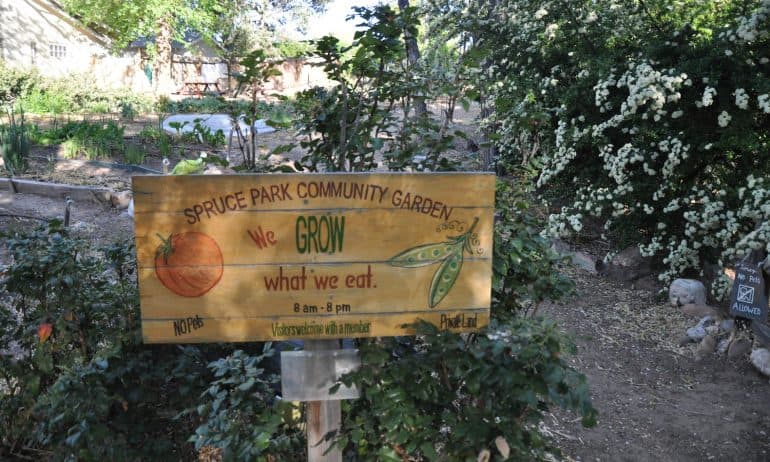The Spruce Park Community Garden adapts to scarce water resources in an arid and urban environment. Located in Albuquerque, New Mexico, the community faces fines of US$20 to US$2,000 for wasting water, enforced by patrolling water cops. Spruce Park serves as an example for local growers by employing specialized landscaping and garden techniques to stretch water resources while boosting productivity.
The garden sprouted from an empty lot near the heart of Albuquerque. Margaret Ménache is the Facilitator and Juliane Bohan is the property owner, and both are Master Gardeners. As Margaret explains, “In starting the garden [the founders] wanted it to help build a sense of community within the neighborhood and to introduce neighborhood kids to food plants and how they grow.”
To conserve water, landscapers employ a style called xeriscaping that requires little to no irrigation or maintenance. Xeriscapers commonly use gravel and local plants, adapted to an arid environment, such as lavender bushes, rosemary, desert willow, and purple smoketrees. New Mexico State University’s Southwest Yard and Garden Plant Advisor includes a database of hundreds of plants ideal for xeriscaping in this region. Spruce Park gardeners grow locally adapted crops like chili peppers and desert herbs.
The original garden soil is sandy loam, common in the region but poor at retaining water. The garden uses drip irrigation hoses to slowly deliver water so roots can soak up more. Water retention is increased by using compost to promote symbiotic fungal growth in plant root systems. Mulch helps reduce evaporation. Unfortunately, the city of Albuquerque currently has no water program to encourage community gardens, but the County does provide a rebate for water barrels.
Compost is important for holding water, lowering fertilizer use, and providing nutrients to the soil, which is often poor quality in the Southwest. Composting needs the right amount of moisture to work effectively. In a desert environment, the Bernalillo County Master Composters recommend periodic soaks, keeping the material in the shade, and using a container with few air holes to keep the moisture up while conserving water.
To combat pests, the garden relies on physical deterrents as much as possible, including tree bags to protect the orchard from green scarab beetles and other insects. Crop rotation is effective at preventing plant-specific pests from becoming too abundant while also improving soil quality. Hawks perch on the edge of the property, keeping fluffy thieves at bay.
Additional resources for beginning and new gardeners in the Southwest include the Desert Oasis Teaching Garden. They draw on the cultural diversity of New Mexico, including the Hopi, Navajo, Pueblo, and Spanish, to develop and implement desert-adapted agriculture. The University of New Mexico offers a Sustainability Studies Program that “utilizes experiential learning, research, and service activities to implement practical solutions for a sustainable future on the UNM campus, in the state of New Mexico, and for the Earth as a whole.” The New Mexico State Cooperative Extension Service has useful resources on its website including crop recommendations and gardening advice. To find a nearby community garden and additional resources, visit the American Community Garden Association.







